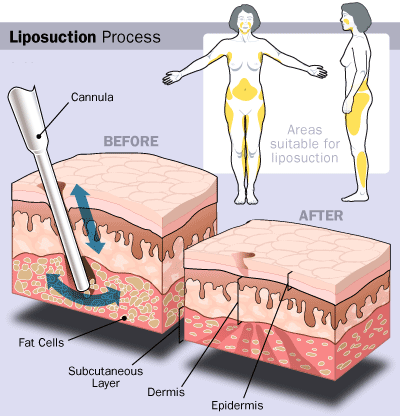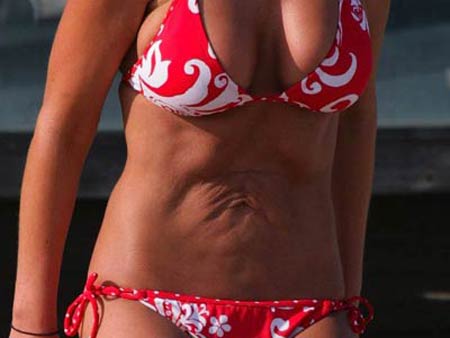



Many women assume that liposuction is the answer to cellulite. What they don't know is that liposuction worsens cellulite and comes with many risks. If you are looking for a cellulite treatment, liposuction is not the answer. Be informed about liposuction and the ten risks of liposuction.
 What is liposuction?
What is liposuction? Liposuction is a cosmetic surgery that removes fat in the body with a suction pump. It is also known as lipoplasty, liposculpture, or suction lipectomy. The procedure involves fat removal underneath the deeper layers of skin. Many patients use liposuction to remove fat deposits from their abdomen, thighs, or buttocks. The amount of fat that can be removed in one session varies with each patient.
There are also several risks factors with removing too much fat. Lumps or dimples in the skin similar to cellulite can be seen on patients who are over suctioned. We will discuss the other risks shortly. Let's move on to liposuction and cellulite.
What is cellulite? Cellulite is superficial fat; fat located just underneath the skin. Since superficial fat is the last to be affected by diet or exercise it is no wonder that no matter how hard you diet or exercise you can't seem to get rid of cellulite. Up until recent years, cellulite was seen as a normal process in women and was not researched. Now new studies have been made along with developments to treat cellulite.
Before discoveries on cellulite were made many people assumed that liposuction could remove unwanted cellulite. However, doctors soon saw that this could be farther from the truth. Liposuction worked to worsen the appearance of cellulite. The reason liposuction is not an effective cellulite treatment is because it treats deeper layers of fat; something cellulite is not. As liposuction removes fat deeper in the skin, superficial skin is stretched and left lax. This lax skin makes cellulite more visible.
The best solution for cellulite would then be a treatment which removes superficial fat such as mesotherapy. Besides making cellulite worst liposuction comes with many risks. Let's take a look at ten liposuction risks.
Another reason that liposuction is not a good cellulite treatment is because it is a surgical procedure. Why choose a risky surgical procedure that doesn't remove cellulite when there are many effective non surgical cellulite treatments available today?
Risks to liposuction depend on patient history, multiple surgeries performed, and the amount of fat being removed during surgery. The dangers of liposuction also vary from mild to life threatening.
 1. Excess skin
1. Excess skin As mentioned above there are certain limits to the amount of fat that could safely be removed by the body. Even if you remove large amounts of fat within the bounds of safety, you may end up with loose skin. This excess skin may need to be removed during liposuction or post surgery.
Another surgery is probably not what you would want after liposuction; especially since these procedures are extremely costly. Even if the loose skin does not require another surgery, it will make your cellulite more visible. If cellulite is your main concern, you will need an effective cellulite treatment thereafter.
During liposuction fat is removed by a hollow tube called the cannula and a suction device known as an aspirator. This removal of fat often causes irregular contours on the body; meaning you will notice unusual lumps and bumps in your body after liposuction. In fact, one report estimates that at least 20% of liposuction patients undergo another surgery to fix contour irregularities in their body.
This disfigurement is a disheartening result since patients expect an ideal physique after surgery.
A minor liposuction risk is scarring. These scars are permanent and are usually hidden in skin creases, pubic hair, or the belly button. Scars range form 4-10 mm long since these are the incision sizes for liposuction. Usually the appearance of scars can be minimized with scar minimizing creams like Mederma.
Swelling may result anywhere from a few weeks to months after liposuction. This may cause pressure on nerves causing patients to experience numbness and tingling. In some cases, fluid accumulates in the body and will need to be drained with a needle. It is recommended that compression garments be used to minimize swelling and fluid buildup.
Infections after liposuction may be mild or severe. Doctors usually prescribe antibiotics after surgery to prevent infection. If an infection does occur, in most cases it can be treated with oral antibiotics when caught early. Signs of infection are redness, increasing tenderness, red streaks visible on the skin, vomiting, and fevers over 101˚ F. Contact your doctor immediately if you experience any of these signs.
Now that you've read about the five minor risks let's take a look at the next five dangers of liposuction.